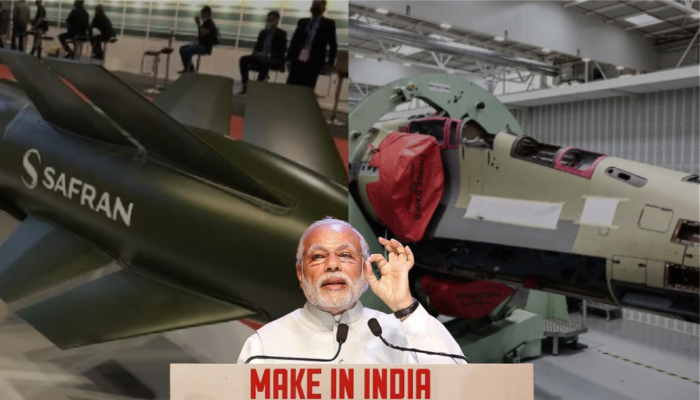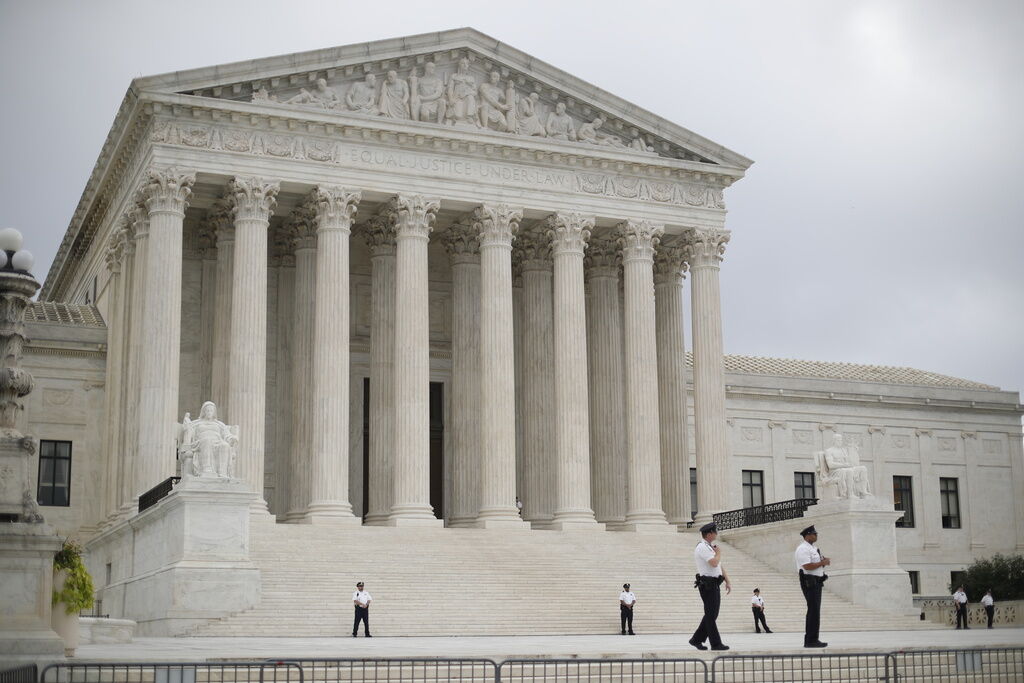Hammer weapons system, indigenous jet engine, Rafale fuselage and more: Modi govt’s “Make in India” receives huge boost in defence production
On 24th November, the French company Safran Electronics and Defence (SED) and India’s state-run Bharat Electronics Limited (BEL) signed a joint venture cooperation agreement (JVCA) to produce the Highly Agile Modular Munition Extended Range (Hammer) smart precision-guided air-to-ground weapon system in India. Additionally, the aerospace giant Safran SA consented to a 100% transfer of technology (ToT) to India for the engine to be made in India for India’s fifth-generation stealth fighter plane, including for the engine’s crucial hot section. Similarly, the Netherlands-based KNDS and domestic defence equipment manufacturer SMPP have joined hands on the KATANA range of precision-guided artillery ammunition. On 20th November 2025, the contract was signed, during the Milipol Exhibition in Paris. Dassault and Tata Advanced Systems Limited (TASL) of India have already decided to collaborate on the production of Rafale aircraft fuselage at a special facility in Hyderabad, in June. These major developments have given a massive boost to Modi government’s ambitious “Make in India” initiative in the defence sector. Hammer weapons system and its function During the confrontation with China in eastern Ladakh (Galwan) in 2020, India used the emergency procurement channel to buy Hammer weapons system and other munitions from France to outfit its Rafale fighter jets. The Rafale planes and the indigenous Tejas Light Combat Aircraft were to be equipped with more of this weapon system. “The JVC shall be formed as a private limited company with 50:50 shareholding. It will localise the manufacturing, supply and maintenance of Hammer to meet the operational needs of the Indian Air Force and the Indian Navy,” the deal highlighted as it formalised the aim stated in the agreement signed by BEL and SED during Aero India on 11th February. The agreement will localise the production, supply, and maintenance of the Hammer weapons system to satisfy the operational requirements of the Indian Air Force and the Indian Navy. Image via Moneycontrol Likewise, important sub-assemblies, electronics, and mechanical parts are going to be produced domestically as the percentage of indigenisation gradually rises to 60%. The government further stated that BEL will oversee final assembly, testing and quality assurance during the phased transfer of manufacturing. The guidance and propulsion package of the Hammer, an air-to-surface weapon, converts ammunition into precision-guided bombs that can carry out close-air support and extensive attacks. Hammer systems integrate GPS, INS and infrared/semi-active laser guidance kits with conventional bombs. It has several warhead variants of 125 kilograms, 250 kilgrams, 500 kilograms and 1,000 kilograms and also offers a range of up to 70 kilometres, depending on the variation. The French company that developed the Hammer weapon system also reported that it has a 99 percent success rate in warfare and can even attack moving targets due to its fire-and-forget capability. It can also be launched over uneven terrain at low altitudes. The system proved its full potential during Operation Sindoor as the Armed Forces destroyed terrorist infrastructure inside Pakistan and Pakistan-occupied Kashmir. The Indian Air Force used Scalp missiles and Hammer munitions fired from Rafale fighter jets to conduct many strikes and raids on terror targets in Pakistan and PoK. Many defence specialists pointed out that India selected the system because of its complete autonomy and immunity to jamming. It was also the ideal choice for breaking through reinforced structures owing to its low-altitude launch ability. India’s own jet engine India is set to approve a joint project by French firm Safran SA and India’s Gas Turbine Research Establishment (GTRE) of the Defence Research and Development Organisation (DRDO) to develop and produce a 120 Kilo Newton jet engine with Indian intellectual property rights (IPR). It will power the twin-engine Advanced Medium Combat Aircraft (AMCA) being designed by the Aeronautical Development Agency, and to be manufactured with the collaboration with the private sector. Olivier Andries, CEO of Safran, conveyed, “It’s a complete transfer of technologies. We along with the Defence Research and Development Organisation (DRDO) are basically going to develop a new engine together in India. This is unique because no one else has made that offer.” reported The Ecomoic Times. Within twelve years, Safran-GTRE would produce nine fighter engine prototype. The capacity of the engines will be increased from 120 KN to 140 KN by the end of the 12-year timeframe, according to Hindustan Times. The engine’s crystal blades, included in 100% technology transfer, are often made from a single crystal utilising super-alloys, are effective, durable and more resilient to elevated heat and stress. Currently, engines of foreign origin power all Indian fighter jets. The Tejas je



On 24th November, the French company Safran Electronics and Defence (SED) and India’s state-run Bharat Electronics Limited (BEL) signed a joint venture cooperation agreement (JVCA) to produce the Highly Agile Modular Munition Extended Range (Hammer) smart precision-guided air-to-ground weapon system in India.
Additionally, the aerospace giant Safran SA consented to a 100% transfer of technology (ToT) to India for the engine to be made in India for India’s fifth-generation stealth fighter plane, including for the engine’s crucial hot section.
Similarly, the Netherlands-based KNDS and domestic defence equipment manufacturer SMPP have joined hands on the KATANA range of precision-guided artillery ammunition. On 20th November 2025, the contract was signed, during the Milipol Exhibition in Paris.
Dassault and Tata Advanced Systems Limited (TASL) of India have already decided to collaborate on the production of Rafale aircraft fuselage at a special facility in Hyderabad, in June. These major developments have given a massive boost to Modi government’s ambitious “Make in India” initiative in the defence sector.
Hammer weapons system and its function
During the confrontation with China in eastern Ladakh (Galwan) in 2020, India used the emergency procurement channel to buy Hammer weapons system and other munitions from France to outfit its Rafale fighter jets. The Rafale planes and the indigenous Tejas Light Combat Aircraft were to be equipped with more of this weapon system.
“The JVC shall be formed as a private limited company with 50:50 shareholding. It will localise the manufacturing, supply and maintenance of Hammer to meet the operational needs of the Indian Air Force and the Indian Navy,” the deal highlighted as it formalised the aim stated in the agreement signed by BEL and SED during Aero India on 11th February.
The agreement will localise the production, supply, and maintenance of the Hammer weapons system to satisfy the operational requirements of the Indian Air Force and the Indian Navy.
Likewise, important sub-assemblies, electronics, and mechanical parts are going to be produced domestically as the percentage of indigenisation gradually rises to 60%. The government further stated that BEL will oversee final assembly, testing and quality assurance during the phased transfer of manufacturing.
The guidance and propulsion package of the Hammer, an air-to-surface weapon, converts ammunition into precision-guided bombs that can carry out close-air support and extensive attacks. Hammer systems integrate GPS, INS and infrared/semi-active laser guidance kits with conventional bombs. It has several warhead variants of 125 kilograms, 250 kilgrams, 500 kilograms and 1,000 kilograms and also offers a range of up to 70 kilometres, depending on the variation.
The French company that developed the Hammer weapon system also reported that it has a 99 percent success rate in warfare and can even attack moving targets due to its fire-and-forget capability. It can also be launched over uneven terrain at low altitudes.
The system proved its full potential during Operation Sindoor as the Armed Forces destroyed terrorist infrastructure inside Pakistan and Pakistan-occupied Kashmir. The Indian Air Force used Scalp missiles and Hammer munitions fired from Rafale fighter jets to conduct many strikes and raids on terror targets in Pakistan and PoK.
Many defence specialists pointed out that India selected the system because of its complete autonomy and immunity to jamming. It was also the ideal choice for breaking through reinforced structures owing to its low-altitude launch ability.
India’s own jet engine
India is set to approve a joint project by French firm Safran SA and India’s Gas Turbine Research Establishment (GTRE) of the Defence Research and Development Organisation (DRDO) to develop and produce a 120 Kilo Newton jet engine with Indian intellectual property rights (IPR). It will power the twin-engine Advanced Medium Combat Aircraft (AMCA) being designed by the Aeronautical Development Agency, and to be manufactured with the collaboration with the private sector.
Olivier Andries, CEO of Safran, conveyed, “It’s a complete transfer of technologies. We along with the Defence Research and Development Organisation (DRDO) are basically going to develop a new engine together in India. This is unique because no one else has made that offer.” reported The Ecomoic Times.
Within twelve years, Safran-GTRE would produce nine fighter engine prototype. The capacity of the engines will be increased from 120 KN to 140 KN by the end of the 12-year timeframe, according to Hindustan Times. The engine’s crystal blades, included in 100% technology transfer, are often made from a single crystal utilising super-alloys, are effective, durable and more resilient to elevated heat and stress.
Currently, engines of foreign origin power all Indian fighter jets. The Tejas jet currently in production use GE engines, and the Tejas Mk-2 under development will also GE engines. The engine and upkeep account for a large portion of a fighter’s cost. Andries disclosed that the scope of work would also include vital components that India would hold intellectual property rights over such as compressors and turbines. According to him, the business is also willing to establish an assembly line for the M88 engines found in Rafale combat jets.
Andries stated that the corporation is attempting to diversify its manufacturing across geography in order to protect itself against unanticipated scenario and India is also becoming a major priority for its commercial aircraft program. It opened a maintenance and repair facility (MRO) in Hyderabad for the Leap engines, which power well-known narrow-body aircraft like the Boeing 737 Max and Airbus A320.
Over 1,300 aircrafts are ordered by IndiGo, Air India and Akasa and are scheduled to be delivered in the coming years. The government’s initiative to localise aerospace maintenance capabilities is well-suited to the plant, which is India’s first and can perform intricate tasks like engine overhauls. It also helps Indian airlines by cutting down on maintenance turnaround times.
Meanwhile, the Aeronautical Development Agency (ADA) has invited domestic companies to submit expressions of interest (EOI) for the creation of the nation’s first indigenous fifth-generation stealth fighter jet, which is a remarkable milestone in the country’s ambitious AMCA program.
SMPP and KNDS prepare to deliver KATANA range of artillery ammunition
One of the top defence and aerospace firms in India, SMPP, has partnered with KNDS to produce KATANA series of precision-guided artillery ammunition through its subsidiary SMPP Ammunition. Ballistic Range (BR), Extended Range (ER) and High Precision (HP) ammunition are all part of the KATANA family. The system is a 155-millimeter precision-guided munition intended to provide accurate and long-range support for artillery operations.
It meets the vital operational requirements of contemporary artillery systems by providing high accuracy and long range. Each variation improves efficacy, accuracy and range. The ammunition use a hybrid guidance system that combines an Inertial Measurement Unit (IMU) with a multi-constellation GNSS receiver to reach decametric-level precision. A semi-active laser seeker would be reportedly included in a future version to attain metric-level accuracy.
The fire-and-forget functionality of the munition makes it suitable for employment in complex and dense locations. This integrated system provides guaranteed accuracy in an array of combat situations and terrains. The KATANA family will be made available to the Indian Army under the “Make in India” program as part of the teaming arrangement between SMPP and KNDS.
According to SMPP, the partnership is in line with the Army’s need for 155 millimetre ammunition and artillery systems.
The company was established in 1985 and produces unmanned aerial systems, medium and large caliber ammunition, platform armouring and human protection systems. Himachal Pradesh and Haryana are home to its operations. KNDS Ammo France is a member of the KNDS Group, which creates and provides land defence systems, including system integration services, mission solutions and ammunition.
Rafale fuselage production in India
Four Production Transfer Agreements have been signed by Dassault Aviation and Tata Advanced Systems Limited to produce the Rafale fighter aircraft fuselage in India. This is a major step towards bolstering the nation’s aerospace manufacturing capabilities and assisting international supply chains.
The front portion, centre fuselage, rear section and lateral rear shells are the main structural components of the aircraft that would be produced in India. With a monthly production capacity of up to two full fuselages, the first fuselage portions are planned to be released by fiscal year 2028.
India is going to manufacture the Rafale fuselage for both local and international markets and are going to be built outside of France for the first time in history.

The CEO and chairman of Dassault Aviation, Eric Trappier, highlighted that this association is a “decisive step in strengthening our supply chain in India.” He pointed out that it fits with the company’s long-term plan to work with Indian aerospace companies like TASL.
“The production of the complete Rafale fuselage in India underscores the deepening trust in Tata Advanced Systems’ capabilities and the strength of our collaboration with Dassault Aviation. It also reflects the remarkable progress India has made in establishing a modern, robust aerospace manufacturing ecosystem that can support global platforms,” voiced Sukaran Singh, Chief Executive Officer and Managing Director of TASL.
He described the arrangement as a turning point in India’s aerospace history, showcasing both the country’s production strengths and the confidence that global aerospace executives have in Indian partners. This facility would be an important hub for high-precision manufacturing and a great investment in India’s aeronautical infrastructure.
Rafale was instrumental in India’s military action against Pakistan after the Pahalgam terror attack. The aforementioned agreements underscore how India is advancing in the indigenisation of its defense sector, thereby offering a substantial enhancement to the “Make in India” campaign.








































































